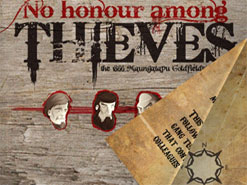
On 12 June 1866, James Battle was murdered on the Maungatapu track, south-east of Nelson. The following day four other men were killed nearby – a crime that shocked the colony. These killings, the work of the 'Burgess gang', resembled something from the American 'wild west'.
The case was made more intriguing by the fact that one of the gang, Joseph Sullivan, turned on his co-accused and provided the evidence that convicted them. The trial was followed with great interest and sketches and accounts of the case were eagerly snapped up by the public. Unlike his colleagues, Sullivan escaped the gallows.
All four members of the Burgess gang had come to New Zealand via the goldfields of Victoria, Australia. Three of them had been transported to Australia for crimes committed in England. They were the sort of 'career criminals' that the authorities in Otago had feared would arrive following the discovery of gold in the province. The South Island goldfields of the 1860s offered potentially rich pickings for criminals. Crime was generally the work of individuals, and often a spontaneous act fuelled by alcohol, but there were notable exceptions.


